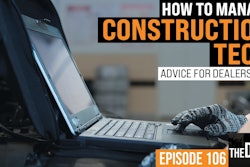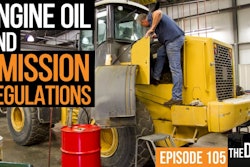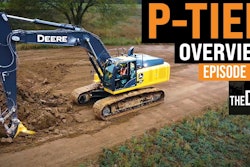Equipment shortages and skyrocketing prices have made being a fleet manager a tough job over the past few years.
In this episode of The Dirt, we hear from Ernie Stephens, senior vice president for equipment management at Infrastructure and Energy Inc., an infrastructure construction company.
One of the first things he notes is that the days of a one-year capital expenditure plan are over. Fleet managers need a three- to five-year plan for equipment purchases and be willing to adjust and be creative in today’s market.
To hear Stephens’ take on the current market and how he has had to change his strategy to keep his company’s jobsite well-equipped, check out the latest episode of The Dirt.
Equipment World serves up weekly videos on the latest in construction equipment, work trucks and pickup trucks – everything contractors need to get their work done. Subscribe and visit us at equipmentworld.com!
In This Episode:
- 00:00 - Intro: How to Manage a Fleet During an Equipment Shortage
- 00:38 - Equipment Acquisition Strategy During a Shortage
- 01:12 - Has the Equipment Shortage Forced You to Try New Brands?
- 02:32 - The Importance of Communication
- 03:05 - How the Current Used Equipment Market Impacts Fleet Management
- 04:20 - How to Make Your Equipment Last Longer
- 06:07 - How to Manage Your Fleet While Also Growing Your Business
- 08:51 - How to Use Telematics to Manage Your Fleet
- 11:15 - How to Network With Other Equipment Managers
- 12:02 - Final Thoughts
Bryan Furnace (00:00):
Hi, everybody. Welcome back to Equipment World. You're watching The Dirt. I'm your host Bryan, and today we're here to talk about fleet management. As we all know, the lead time on new equipment from the factory combined with the fact that used equipment prices are through the roof has had to make us get creative as contractors on how we manage our fleets.
(00:26):
Here to talk with us today, is Ernie Stephens and he's going to break down how he handles it at the large scale so that we can take some of his knowledge and maybe apply it to some of our small to mid-size companies. With a lot of the OEMs still one to two years out on their backlog, what impact has that had for you guys on your strategy when it comes to acquiring equipment?
Ernie Stephens (00:49):
Sure. The days of looking at annual capex just isn't enough. You have to have that three to five-year plan. Once you get your plan in place, you have to immediately get your partners in place, the OEMs. Then you have to see what they can provide and get those timelines written down. Then you have to go to the third-party vendors, the rental houses, and you have to supplement, more so than we've ever done as well.
Bryan Furnace (01:14):
I'm sure, like most companies, you have one, two, maybe even three preferred manufacturers that you like to keep your inventory with. Has this forced you to go outside of that, or are you just retooling from a timing standpoint?
Ernie Stephens (01:30):
There was definitely a 12- or 18-month period, people were grabbing any color, brand, even the size didn't matter. Looking for a mid-level excavator and all they have is a large, we will take it. I think we're on the decline of that and trying to get back to our favorites, but I think it was a great opportunity for everyone to get their brands out there and for us to try it. I think a lot of people were going to be surprised with how well a lot of that equipment that they didn't normally run, performed. So excited to see how those trends will continue moving forward.
Bryan Furnace (02:02):
I will say that's been huge because you've traditionally had a handful of players at the top that everyone considered, "Well, if you're a professional in the industry, this is who you go with." Due to the equipment shortage, I think a lot of people have had to get outside of their comfort zone, and they're starting to discover that in order to compete in the equipment market in general, you can't put just garbage out on the market. There's a lot of good machines on the market that are very competitive with the big, well-known brands if you will.
Ernie Stephens (02:31):
For sure. I think it always dials back to communication. You can't even estimate the job unless you're going to have the equipment for that job. If you are going to go in with the estimate and hope to win it, you better be talking to your partners right away and which is something that we've been doing for the last, probably three to four years. Any large projects that we have, we'll go to the OEMs right away, "Hey, we're looking to bid this type of project in this region, just forewarning you. Even if we don't win it, someone's going to win it and need that equipment." So I think having those partnerships and relying on each other, it's helped us a lot.
Bryan Furnace (03:04):
So another interesting dynamic that's come out of this is the used equipment market. Prices have skyrocketed on that equipment, and so, I guess, it's a little bit of a two-part question. The first is, has that changed your strategy for offloading equipment in any way? And then secondly, do you guys find yourself acquiring used equipment rather than just brand-new equipment? And has that forced your hand, changing on that side of the acquisition strategy as well?
Ernie Stephens (03:35):
Yeah, I never have had to buy the used market before. Unfortunately, we haven't been able to sell as much either because you'd have nothing to replace it. I think what's been the game changer for us is that rental market, which I mentioned. You're not buying a 8,000-hour machine at auction, you're renting a 3-to-4,000-hour machine. You're going to have the productivity and the uptime on those, and that's the shortfall or the gap stopper there, having those rental possibilities when you can find them. So our strategy has extended the useful life, going back to preventative maintenance and taking care of our equipment that we do have, planning it. It's end-life to be when the new equipment's coming and if it doesn't make it that long, it's filling in the gaps with rentals.
Bryan Furnace (04:20):
So could you expand a little bit because a lot of guys are in the same boat? The real only solution that they've got at their disposal is, "I have to make my existing fleet last longer," and that comes with a lot of strategizing. You can't just one day magically decide, "Oh, we're just going to hold on to everything for an extra two or three years." Can you talk us through some of the discussion you've had and some of the thought process you've followed to do that in a healthy way where we're not going to end up with a bunch of mechanical failures or get overwhelmed in maintenance costs here in another two to three years?
Ernie Stephens (04:52):
For sure. I think the keyword there was outsourcing. You've got to find out what you're good at, and that's you as an equipment department, you as a company, what is your core business? For me, it's working on specialty-type equipment. Do I need mechanics and technicians to be the best dozer mechanic or the best excavator guy? No, I need the crane guys. I need the drill rate guys, the paving guys. That's our specialty and that's how we make our bread and butter. So how do you fill that gap when you're keeping your dozers and excavators longer and you want them to continue that high level of work at that age? You have to partner with the dealers.
(05:31):
We've done a lot of preventative maintenance contracts with them on the hour, on a monthly basis. They'll come out there, change our oils. They're the experts out there. In order to keep those guys on staff, for us, it would take up a lot of time and resource that can be better spent, again, in our core business. So if you look at outsourcing that, and on a volume basis, you're going to get better discounts than just one, "Hey, can you call a guy and go out and change the oil on this, do a B-service or something?" If you're doing your whole fleet, now you're talking scalability and the volume will definitely get you a little bit better pricing.
Bryan Furnace (06:05):
Great advice. My final question is, for maybe some of these small to mid-size companies that are getting ready over the next couple of years to step up into that next tier of becoming a larger contractor, any advice you can give to them on overall fleet management, how to think about this, how to strategize and plan for the future?
(07:37):
Any advice you can give to them on overall fleet management? How to think about this, how to strategize, and plan for the future?
Ernie Stephens (07:44):
For sure. Leaders come in all shapes and sizes and finding one that really can communicate, someone that has the technical skills, but the leadership and communication side, it's a good mix. That Gen X is definitely where we're focused on right now, working with groups like AEMP and ACEM. We're training the next level of leaders out there because a lot of the older generations are retiring. So you've got to do all you can to be a sponge around them and then figure out how to train the next generation. So we're spending a lot of time and resources on those type of classes and trainings.
(08:15):
On the technology side, we definitely want to make sure that everyone's using some type of telematics out there. There's so much that it offers, but yet, how is it going to help you the most? You've got to focus on preventative maintenance, getting the hours coming in, and then you want to check in on utilization, uptime. Then lastly, I like to focus on idle time. So find one to two things to focus on for telematics. Don't try to do all 20 things that it can do. If you focus on one or two per year, work with your provider, you're going to get those results a lot faster, and you're going to continue to grow and get payback on that investment.
Bryan Furnace (08:51):
Telematics is an interesting little side conversation. I think for a lot of smaller contractors, but even at the mid-size, I think there's a lot of guys that look at that screen and go, "Well, that's neat and nifty, but what am I supposed to do with this?" Can you give a little, don't necessarily give away the secret sauce, but can you give us an idea of how you're thinking about that information other than, "Oh, that's a neat graph"?
Ernie Stephens (09:15):
Yeah. Again, I think it comes back to partnerships. You've got to find a provider that's going to give you what you want and how it's going to fit your business model. Just because we're all in construction, we all have a little bit of a different business model and no one does it the same, from the backend accountings to the front-end operations. So when you pick that provider, you can't just say, "This is your box and make it work for you guys." You have to find someone willing to work with your company and there's going to be some customization. You get to a size company like us, over 2 billion, we're doing a lot of customizing on import, on the data, using rivet along with our provider, tying that back into our accounting system just to make it work, and it's a daunting task.
(09:57):
I think if you're a mid-level and up, you need to have one focused person and that's all they do, is telematics. They have to be the king or queen. A lot of times throughout my career, I've always tried to dabble in the telematics. As a leader, you put it on the front stove and before long, it's not even on the stove, let alone on the back burner. There's always something that you got to be moving to. You need that dedicated staff just to focus on that and integrating it in your everyday systems.
(10:24):
I think some of the biggest pushes we've seen, again, is fixing the preventive maintenance side, getting the hour tracking, but then as soon as you can, pushing that information into the field. The operation side is so hungry for information on utilization, where their equipment's at, what's sitting and idling. I'm using four dozers and only three of them are working steady. Why do I have that fourth one out there? That type of information, getting it to the field and trying to customize it for them. You're going to see huge gains in the company.
Bryan Furnace (10:52):
Great advice. Thank you. Thank you for all of this. I think for a lot of people, the struggle when you go from being the little guy to the mid-size guy, you start to get into a lot of areas of technology and tracking, and you're getting much more analytical about parts of the business that you've not really had to be analytical in before, and I think that's pretty daunting to a lot of people.
Ernie Stephens (11:14):
For sure. One of the groups that's helped me get to where I am is AEMP, it's the Association of Equipment Managers, and we do a lot of classes, a lot of training, but I'll tell you, the biggest part of it's the networking. You're sitting in a room with 2 or 300 other equipment managers. What else is there to do, but have a beer with these guys? You're talking about what works, what doesn't work. No reason to repeat the wheel when it's already been made somewhere else.
Bryan Furnace (11:39):
Absolutely.
Ernie Stephens (11:39):
Just having that network in your back pocket. I actually had a call this afternoon with a guy up in Canada, a fellow equipment manager who just wanted to get 10 minutes of my time to ask a few questions on what I'm doing in a couple of areas of the business, and always happy to share that knowledge with others.
Bryan Furnace (11:56):
Great advice. Well, Ernie, thank you again for the time. I really appreciate it.
Ernie Stephens (11:59):
Oh, my pleasure, Bryan.
Bryan Furnace (12:01):
Well, thank you again to Ernie for coming on the show and giving us a little insight as to how some of the big players in the market start to think about their equipment fleet, as we deal with some of these unique factors that we haven't had to deal with for, as far as I can remember in the industry. This is a very unique time. So hopefully, this can help you in your business. As always, thanks for watching, and we'll catch you next time on The Dirt.









